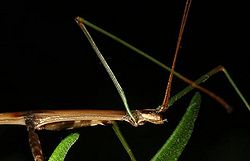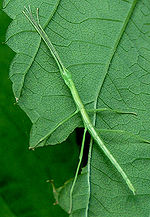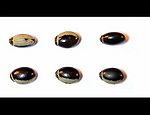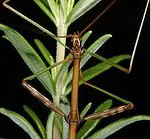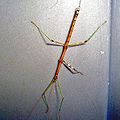Northern walkingstick
| Northern walkingstick |
|---|
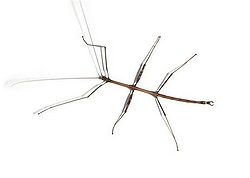
|
| Scientific Classification |
|
| Binomial Name |
|
Diapheromera femorata |
| Northern Walkingstick |
The Northern Walkingstick is a species of walkingstick known by the scientific name Diapheromera femorata). The common name fits it quite well having a long, slender, and that very much resembling a typical branch.[1] It is a slow moving bug that may not even move for hours and even sometimes does a little swaying type motion that looks like a twig moving in the wind, and can change colors to both green and brown. [2] [3] Being one of the most common species of walking stick in the United States, it is one of the few non-tropical Phasmids that are native to North America[4], being found in vegetation throughout most of United States, southern Ontario, and Quebec. [5]
Anatomy
The Northern Walkingstick appears as a small branch, appropriate for keeping away from predators and capturing prey. Males will usually take on a stricter brown color and the female will appear to be a more green brown color. Both male and female have antennae and the antennae is about two-thirds the size of the overall body. Northern Walkingsticks vary in size between the sexes. Males will usually measure out at about 75mm(3in.) though females usually are much larger in varieties and are about 95mm(3 3/4in.).[6] As insects they have a three part body: the head, thorax, abdomen and have six legs. They have a tough outer skin known as the cuticle, and breathing is accomplished by about 20 small openings called spiracles, which can be found down the side of the body that take the air to skin tissue. The antennae are covered with tiny hairs which can detect changes, such as, a change in temperature, body position, and chemical this would be like smells. These hairs are there, in fewer numbers, over the rest of the body as well. They have two compound eyes which enable them to see clearly and in color. They have two claws and four suction pads on their feet. This enables them to climb a variety of surfaces, including glass. [7] Both sexes are slender and wingless, with long, thin legs and antennae. Some adults are all brown or green, while others are spotted or multicolored with dark or light shades of grays, greens, reds, and browns. [8]
Reproduction
The Northern Walkingstick is parthenogenetic - meaning the females can lay fertile eggs without any male assistance. It seems like the eggs develop in such a way that they make the equivalent of true eggs and sperm which can then join together to produce a true egg. There may be only one male to every thousand females in captive populations, and after this happens the females drop several eggs a day. [9] There eggs are seed like and oval about 2.2 mm. long, 1.5 mm. wide and 1.0 mm. deep. It has a very hard and shiny black or brown shell with a broad white or olive-colored band on one edge. One end has an indistinct brown cap which is where the nymph emerges. The newly hatched nymphs looks like a miniaturized model of the adult, and they are a delicate pale green color and measures about 5/16 in long.[10] Overwintering the eggs in leaf litter hatch in May and June (around 9 months). [11] Then the Nymphs (baby walkingstick) become adults during the summer and this happens after about five or sixth molts that are done upside down . Females drop up to 150 eggs, which are literally dropped randomly to the forest floor, [12] but some eggs are dropped, some buried, some glued to surfaces. [13] There is one generation per year in the South, but 2 years are required in the farther North. [14]
Ecology
The Northern Walkingstick is a defoliator of deciduous trees in North America. Because of its shape, this insect is also commonly called the stick bug and depending on your location it could be called one many of other things. [15] The northern walkingstick has many places it can live and it is used to places for its food it’s like a living storehouse for them. They generally eat Black Oaks, White Oaks, Willow Oaks, Black Locusts, Virginia Roses, Sassafras, Black Cherries, and Red Clovers and they also live in these and trees and plants they eat. [16] So this makes them a parasite for the trees they live in because in the type of relationship, the northern walkingstick (parasite) gets helped, and the trees (host) are harmed, and the walkingstick lives on the tree, [17] but they have a lot of predators too like the common grackle and the Five-lined Skink and Eastern Chipmunk. [18]
Other
Northern Walkingstick insects do not eat continuously, but eat during the day and night. They produce only uric acid as a waste material, with the droppings being fairly dry and odorless. [19] They usually are very good at faking death when attacked, by dropping to the ground and becoming virtually invisible. They generally are more active feeders at night. They are usually in the majority of warmer climates that range from 75º to about 80ºF. [20] The northern Walkingsticks are from the family known as phasma meaning ghost and is referring to the excellent way they seem to disappear into the foliage.
Gallery
References
- Northern Walkingstick InsectIdentification.org.
- Classroom Animals and Pets - Insects and Co.- Walking Sticks auther, publisher, April 2002.
- Stick Insects Males Not Needed for Reproduction John Blatchford, Aug 25, 2007.
- EOL Diapheroa Phil Myers, Museum of Zoology, University of Michigan, Václav Hanzlík, and J. C. Lucier, 1824, Jul 2008 .
